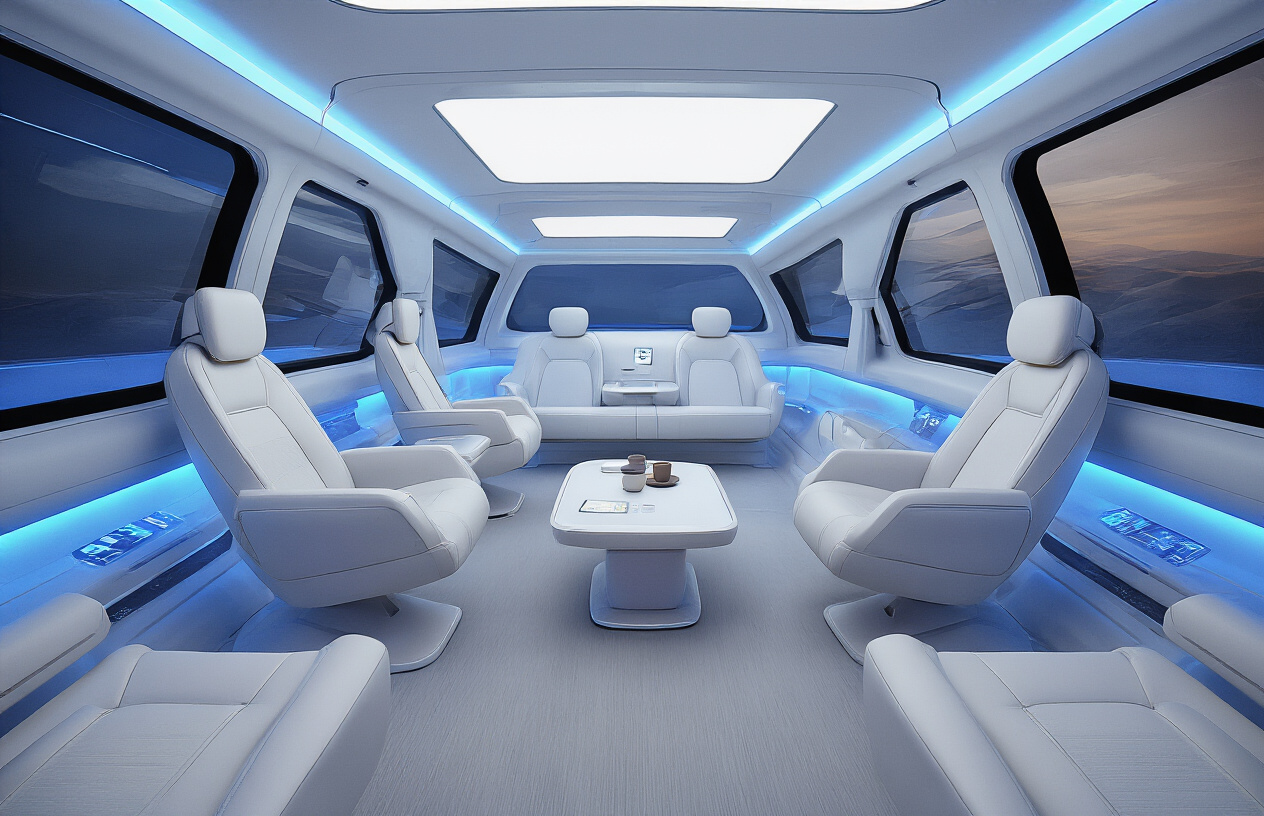Ever wondered what it would feel like to nap while your car drives you to work? Or have your vehicle park itself when you’re running late for dinner? Buckle up, because that future isn’t decades away—it’s practically in your driveway.
The next five years will revolutionize everything you thought you knew about driving. From cars that predict traffic jams before they happen to vehicles that charge themselves without a plug.
The future of automotive technology is racing toward us faster than most people realize. And honestly, the cars coming between 2025-2029 will make today’s “advanced” vehicles look like antiques.
But here’s what nobody’s talking about: are regular drivers actually ready for this shift? Because the technology is ready for you, whether you’re prepared or not.
Autonomous Driving Technologies Dominating 2025-2029
Level 4 and 5 Self-Driving Features Becoming Standard
Remember when Tesla Autopilot seemed futuristic? Fast forward to 2025, and Level 4 autonomy isn’t just for luxury vehicles anymore. Mainstream cars now handle entire trips without driver input in most conditions.
By 2027, we’re seeing Level 5 autonomy creeping into mid-range models. Your car literally does everything—rain, snow, unmarked roads, construction zones—the works. No steering wheel required (though regulations still mandate them in most places).
The price? Dropping like a rock. What cost $15,000 as an option in 2023 comes standard in a $35,000 vehicle now. Manufacturers realized autonomous tech sells cars faster than horsepower ever did.
Advanced AI Navigation Systems That Learn Your Preferences
Your car now knows you better than your spouse. No joke.
These new AI systems track everything—where you go, when you go there, how you like to get there. Monday morning? Your car already knows you’ll want to stop for coffee before work. Friday evening? It’s suggesting that Thai place you love.
The really mind-blowing part? It adjusts based on your mood. Had a stressful day? The AI detects it in your voice patterns and suggests a scenic route home instead of the fastest one.
Smart Infrastructure Communication Capabilities
V2X (vehicle-to-everything) communication isn’t just fancy tech talk anymore. Your 2026 model constantly chats with traffic lights, other vehicles, and even pedestrians’ smartphones.
The result? Traffic flows like water. Your car knows exactly when that light will turn green or that a truck two intersections away is about to make a wide turn.
Cities that have upgraded their infrastructure report 43% fewer accidents and 27% reduced commute times. Not all urban areas are fully equipped yet, but by 2029, it’ll be as standard as traffic lights.
The End of Parking Hassles: Self-Parking and Retrieval
Gone are the days of circling the block for parking. Your car drops you at the entrance and finds its own spot—sometimes blocks away in designated autonomous parking zones.
Need your car back? Just tap your app. Your vehicle navigates back to you, timing its arrival precisely when you’re ready to leave.
This tech has transformed urban planning. New buildings require 40% less parking space, allowing for more housing, parks, and businesses where concrete structures once dominated.
Electric Revolution: Beyond the Basics

A. 500+ Mile Range Batteries as Standard
Remember when 250 miles of range was impressive? Those days are about to look prehistoric. By 2026, most electric vehicles hitting the market will pack 500+ mile ranges as standard equipment. Not premium. Not an upgrade. Standard.
The battery tech revolution isn’t coming—it’s already happened in the labs. Solid-state batteries aren’t just hype anymore. They’re moving from research papers to production lines as we speak. Companies like QuantumScape and Toyota have cracked the code, doubling energy density while cutting weight by 30%.
What does this mean for you? Road trips without the range anxiety. No more planning your day around charging stops. No more watching the battery percentage like it’s a ticking time bomb.
B. Ultra-Fast Charging: Full Power in Under 10 Minutes
Gas stations aren’t disappearing—they’re evolving. The 2025-2027 wave of EVs will charge faster than you can finish your coffee.
The 350kW chargers we have now? Cute toys compared to what’s coming. We’re talking 800kW to 1MW charging stations that’ll add 300 miles in about 8 minutes. Porsche and Hyundai are already testing systems that make Tesla’s Superchargers look like they’re charging through a garden hose.
C. Bidirectional Charging: How Your Car Will Power Your Home
Your next car isn’t just transportation—it’s a giant battery on wheels that’ll slash your electric bill.
During a blackout, your Ford F-150 Lightning can already power your home for days. By 2026, every EV will do this, plus more. They’ll automatically sell power back to the grid during peak hours and buy it during cheap ones. Early adopters are already saving $1,500 annually on their electric bills.
D. The Extinction Timeline for Combustion Engines
The writing’s on the wall, folks. Gas cars aren’t going extinct overnight, but their days are numbered.
By 2027, most major manufacturers will stop developing new combustion engines entirely. Their R&D dollars are already flooding into electric platforms. GM, Volkswagen, and Volvo have set hard end dates for gas vehicle production between 2030-2035.
The used market will follow a pricing cliff we’ve seen before with obsolete tech. Remember how fast CRT TVs became worthless? The same thing’s happening with gas guzzlers.
E. Subscription-Based Power Upgrades
The most controversial trend coming? Your car will have hardware capabilities you’ll need to “unlock” with your wallet.
BMW already charges a subscription for heated seats in some markets. Tesla sells acceleration boosts via app. By 2026, this will be standard practice across the industry.
Your car might have 400 horsepower hardware but ship with only 300 “activated.” Want the full power? That’ll be $49.99 a month. Limited-time promotional upgrades during road trips. Temporary performance boosts for track days.
The future of cars is software-defined. The upside? Your vehicle gets better over time. The downside? Get ready for car features to follow the Netflix model.
Reimagined Car Interiors for the Autonomous Age

A. Living Room on Wheels: Fully Reconfigurable Spaces
Remember when cars were just for driving? Those days are disappearing fast.
The 2025-2029 models are turning vehicles into actual living spaces. We’re talking seats that swivel 180 degrees to face each other. Imagine having a conversation with your passengers while looking them in the eye—not stealing glances in the rearview mirror.
The new Mercedes EQS Lounge and BMW i8 Vision are pioneering modular interiors where seats fold completely flat or arrange in a circle. Some models feature removable center consoles that transform into tables for work or dining.
And it’s not just luxury brands. By 2027, even mid-range vehicles will offer interiors that change based on driving mode. In autonomous mode, steering wheels retract into the dashboard, creating space that simply didn’t exist in traditional vehicles.
B. Windshields as Interactive Displays
Your windshield is becoming the world’s largest smartphone screen.
Augmented reality displays are now stretching across the entire front glass. The 2026 Audi e-tron Vision projects navigation arrows directly onto the road ahead. Weather information, restaurant reviews, and traffic alerts appear as you approach them—no more squinting at a tiny screen.
Gaming during your commute? Absolutely. When parked or in autonomous mode, windshields transform into cinema-quality displays. The new Hyundai Ioniq Series offers split-screen functionality so passengers can watch different content simultaneously.
The coolest part? Gesture controls mean you wave your hand to answer calls or swipe through options without touching anything.
C. Biometric Controls and Personalization
Keys are officially ancient history.
Cars now recognize you before you even touch the door. Facial recognition, fingerprint sensors, and even gait analysis unlock vehicles as you approach. The 2025 Toyota Concept-i learns your preferences over time—adjusting seat position, temperature, music, and even driving dynamics based on your mood.
Stress sensors built into steering wheels detect when you’re tense and automatically adjust lighting, music, and even scent to calm you down. The Volvo EX90 has eye-tracking technology that knows when you’re distracted or drowsy and responds accordingly.
Voice controls have evolved beyond basic commands. You can have actual conversations with your vehicle’s AI. “I’m running late for a meeting” automatically triggers your car to find the fastest route and notify your calendar contacts.
The Connected Car Ecosystem
Car-to-Everything (C2X) Communication Benefits
Remember when cars were just, well, cars? Those days are gone. The vehicles hitting the streets between 2025-2029 won’t just drive you around—they’ll be constantly chatting with everything around them.
C2X communication is the game-changer we’ve been waiting for. Your car will talk to other vehicles, warning you about that guy who slammed on his brakes half a mile ahead. It’ll communicate with traffic lights so you know exactly when that red light turns green. No more guessing games.
The safety implications are massive. Studies show C2X could prevent up to 80% of non-impaired crashes. Think about that. Your car will know about dangers before you do—like the truck running a red light or the cyclist in your blind spot.
And traffic jams? They’ll become relics of the past. Your connected car will reroute you around congestion before you’re stuck in it, saving the average commuter about 70 hours annually. That’s nearly three full days of your life back every year!
Smart City Integration Features
The coolest cars of 2025-2029 won’t just connect to other vehicles—they’ll become active participants in smart cities.
Picture this: You’re heading downtown for dinner. Your car automatically finds and reserves parking, guides you directly to the spot, and handles payment. No more circling blocks or fumbling for change.
Smart cities will prioritize connected vehicles at intersections based on occupancy and emergency status. Full bus coming through? It gets priority. Ambulance nearby? Traffic parts like the Red Sea.
Your vehicle will tap into city infrastructure to warn about road conditions—potholes, ice patches, construction—before you encounter them. Some models will even report infrastructure issues to city maintenance crews automatically.
The real magic happens with energy management. Electric vehicles will coordinate charging schedules with the power grid during off-peak hours and potentially sell excess power back during high demand. Your car becomes part of the city’s energy solution.
Predictive Maintenance That Eliminates Breakdowns
The days of unexpected breakdowns leaving you stranded on the highway? They’re history.
The 2025-2029 generation of vehicles comes equipped with hundreds of sensors continuously monitoring every component. Your car won’t just tell you when something’s wrong—it’ll predict failures before they happen.
AI algorithms will analyze patterns in your specific driving habits, environmental conditions, and component wear to create personalized maintenance schedules. Your car might notify you: “Based on your frequent short trips in cold weather, your battery will need replacement in approximately 43 days.”
Most impressive is the self-healing capability. Many components will automatically adjust their performance parameters when degradation is detected. Your transmission might shift differently to reduce stress on wearing parts until you can get it serviced.
Manufacturers are rolling out subscription services that handle everything—scheduling appointments when problems are predicted, ordering parts in advance, and even sending mobile technicians to your location. Complete peace of mind on four wheels.
Digital Twin Technology for Your Vehicle
Digital twin technology might sound like sci-fi, but it’s about to transform your relationship with your car.
Every new vehicle will have a virtual replica—a digital twin—living in the cloud. This isn’t just a digital manual; it’s a dynamic, evolving model that mirrors your actual car in real-time.
The twin records every mile driven, every maintenance performed, every modification made. Need to troubleshoot an issue? Mechanics won’t have to guess what’s wrong—they’ll simulate different scenarios on your car’s digital twin to pinpoint the problem.
What’s truly revolutionary is how this affects resale value. Used car buyers won’t rely on your word about maintenance history—the digital twin provides an unalterable record of the vehicle’s entire life. Well-maintained cars will command premium prices based on verified data, not promises.
Personalization reaches new heights too. Test different accessories, modifications, or even paint colors on your digital twin before making changes to the physical car. Want to see how those 20-inch rims look before dropping two grand? Your digital twin has you covered.
Ownership Models Transforming by 2029
A. Subscription-Based Car Access vs. Traditional Ownership
Car ownership is dying. Not overnight, but it’s happening.
By 2029, most urban dwellers won’t see the point of dropping $50,000 on something that sits unused 95% of the time. Instead, they’ll pay $299-599 monthly for subscription services that give them access to different vehicles whenever they need them.
Think about it – Monday you need a compact for commuting, Friday you want an SUV for a weekend trip, and next month you’re eyeing that convertible for summer. With subscriptions, you just swap them out through an app.
Companies like Volvo, Porsche, and newcomers like Lynk & Co are already showing us the future:
| Traditional Ownership | Subscription Model |
|---|---|
| Large upfront cost | Low/no down payment |
| Single vehicle | Access to multiple vehicles |
| Maintenance headaches | All-inclusive service |
| Depreciation losses | No long-term commitment |
The numbers tell the story – subscription models are growing 71% year-over-year while traditional financing is flat. Most major manufacturers are scrambling to create their own programs because they see the writing on the wall.
B. Autonomous Ride-Sharing Economics
The math behind self-driving taxis is about to break the transportation industry wide open.
When you remove the driver from the equation (who typically takes 70-80% of the fare), the cost of getting from A to B plummets. We’re talking $0.25 per mile instead of $2.50.
Waymo and Cruise are already running driverless taxis in select cities, but by 2029, they’ll be everywhere. The economics are simply too compelling to ignore:
A typical car owner spends about $9,000 annually on their vehicle. Compare that to someone using autonomous ride-sharing at roughly $3,000 per year for the same amount of travel. The savings are massive.
For companies, each self-driving taxi can generate $300,000+ in revenue annually while operating nearly 24/7, compared to privately-owned vehicles that sit idle most of the time.
The ripple effects are enormous. Parking lots will become obsolete. Gas stations will transform. And two-car families might become zero-car families, putting that garage space and car budget to better use.
C. Fractional Ownership Platforms
Not ready to give up ownership entirely? Fractional ownership might be your sweet spot.
Think of it as the timeshare model, but for vehicles. You and 3-5 other people co-own a single vehicle, splitting all costs proportionally. You each get guaranteed access for specific days or hours, managed through blockchain-secured scheduling apps.
By 2029, this model will make luxury and specialty vehicles accessible to the average person:
“I could never afford a $120,000 Porsche on my own, but owning 1/4 of one for $30,000? That works for my budget and my lifestyle.”
Startups like Curbo and ShareMyCar are pioneering this approach, focusing on premium vehicles that people want occasional access to but can’t justify owning outright.
The technology makes it seamless – smart locks, usage tracking, automated billing, and even maintenance scheduling happen in the background. No more awkward conversations with your co-owners about who left the tank empty.
D. The New Insurance Landscape for Self-Driving Vehicles
Insurance for self-driving cars in 2029 will look nothing like today’s policies.
Who’s responsible in an accident – the passenger, the manufacturer, or the software developer? The industry is completely reinventing itself around this question.
Per-mile policies will become standard, with rates dynamically adjusted based on real-time risk factors. Drive in bad weather? Your rate goes up temporarily. Let the AI take complete control? Your rate drops substantially.
The most fascinating shift: insurance will move from the individual to the vehicle itself. Each autonomous car will carry its own policy, with costs distributed across all users.
Data shows accident rates with Level 4+ autonomous vehicles are already 90% lower than human drivers. By 2029, insurers will have refined their models to reflect this reality.
Some innovative policies already emerging:
- Usage-based microinsurance that activates only when you’re in the vehicle
- Subscription bundles that include both vehicle access and insurance
- Reputation-based premiums that decrease as your autonomous vehicle builds a safe driving history
The old insurance industry won’t recognize itself by the end of the decade. And for consumers, that’s mostly good news.
The automotive landscape of 2025-2029 promises to be revolutionary, with autonomous driving technologies taking center stage in our daily commutes. Electric vehicles will evolve far beyond today’s models, offering enhanced range, faster charging, and innovative power solutions. Meanwhile, car interiors will transform dramatically to accommodate our new role as passengers rather than drivers, creating spaces designed for productivity, entertainment, and relaxation.
As vehicles become fully integrated into our digital ecosystems, the connected car will serve as an extension of our homes and workplaces. Perhaps most significantly, traditional car ownership will give way to flexible subscription services and shared mobility solutions. Whether you’re an early adopter eager to embrace these changes or someone watching cautiously from the sidelines, one thing is clear: the future of driving isn’t just approaching—it’s already here, and the time to prepare for this transportation revolution is now.




